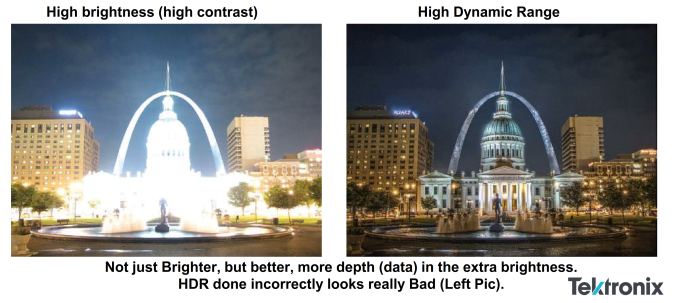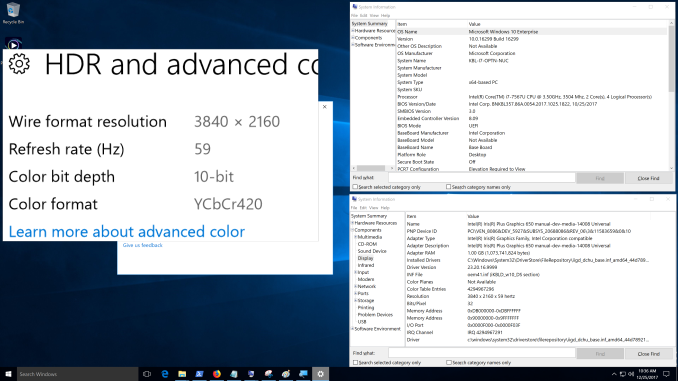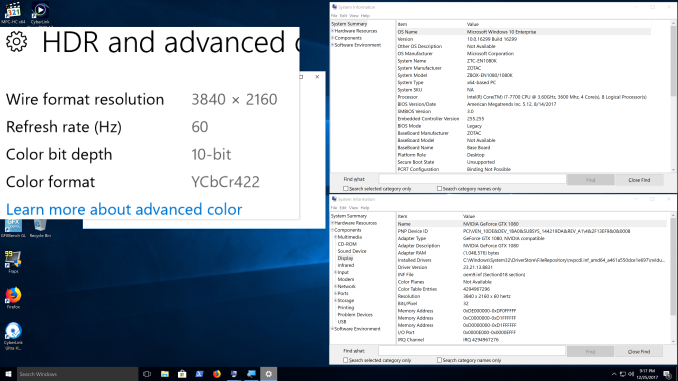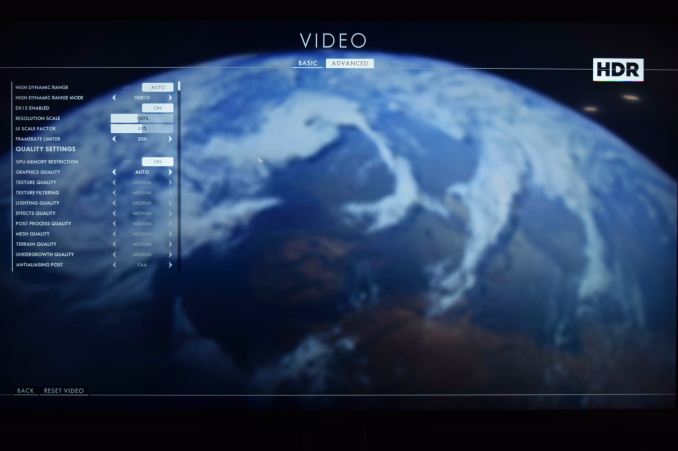A Budget Home Theater & PC Setup: 4K, HDR, UHD Blu-ray, and More
by Ganesh T S on December 26, 2017 8:30 AM ESTHDR Support
High Dynamic Range (HDR) is one of the most impressive features in the recent crop of 4K televisions. In layman's terms, it refers to the ability of a single frame to have wide variation in brightness for different regions. This allows the details in the dimly lit areas of the frame to be seen more clearly. Overall, it delivers a more vivid picture to the viewer. Note that this is quite different from the concept of high contrast.
Picture courtesy: SMPTE HDR Presentation from Steven Holmes of Tektronix
The ability of a display source to transmit HDR frames, as well as that of a display sink to be able to accept and understand them, can be gathered from the HDMI port's specifications. However, being able to accept and understand is only part of the problem. There are many low-cost 'fake HDR' TVs that simply parse the HDR information, but, do not have the ability to translate that to the display.
There are many HDR 'standards', with the base requirement being HDR10. Shifting a display sink into HDR mode involves the source sending some information (metadata) with the characteristics of the video being transported (the mapping of the pixel data to the displayed luminance, light levels in the video stream etc.). If this is static (i.e, done once when the shift to HDR mode occurs), it falls under the HDR10 category. Dolby Vision allows for the metadata to change on a frame-by-frame basis (dynamic). The upcoming HDR10+ standard will also support dynamic metadata. The takeaway is that Dolby Vision certification all but ensures a display with true HDR capabilities.
The TCL 55P607 comes with standard HDR10 and Dolby Vision support. The native Roku apps shift to the appropriate HDR mode based on the content being played back. We will analyze this more in the subsequent sections.
The NVIDIA SHIELD Android TV (SATV) is similar to the native Roku app in the TV with respect to treatment of HDR content. The main issue is that SATV doesn't support Dolby Vision yet, though there is a lot of clamor for it from SATV owners. Videos with HDR10 metadata shift the display to the appropriate HDR mode prior to playback.
PCs encounter additional challenges for HDR implementation. It is just not one company that is responsible for the feature. On one hand, the GPU driver vendors need to support it. On the other hand, the OS itself needs to provide hooks to enable HDR. Finally, the software ecosystem needs to catch up. The Windows 10 Fall Creators Update brought HDR10 capabilities for the Windows desktop into the stable ring. It also allowed streaming of HDR videos from YouTube and Netflix. Microsoft is continuing to fine-tune the HDR capabilities built into Windows 10.
Intel, along with CyberLink, had decided not to wait for Microsoft to deliver HDR on PCs. PowerDVD 17 was the first software Blu-ray player, and it only made sense for them to support HDR playback for applicable titles. The Intel / CyberLink solution for HDR when playing back certain Blu-rays in full-screen exclusive mode is orthogonal to Microsoft's HDR support.
The Windows 10 Fall Creators Update enabled desktop HDR and HDR video streaming on all the three test PCs described earlier.
HDR and Advanced Color Settings - Intel NUC7i7BNHX1 with Desktop HDR Enabled
The KBL-U platforms drove the display at YCbCr 4:2:0 10-bit, while the NVIDIA GTX 1080 drove the HDR output with higher quality (YCbCr 4:2:2 10-bit). For a good desktop experience, 4:4:4 is preferable.
HDR and Advanced Color Settings - Zotac ZBOX MAGNUS EN1080K with Desktop HDR Enabled
Gaming is not a focus in our HTPC reviews, but, we must give credit to NVIDIA for supporting Dolby Vision in their Pascal GPUs. Certain gaming titles such as Battlefield 1 support both HDR varieties (HDR10 and Dolby Vision), and the Zotac EN1080K is able to deliver it in a HTPC environment, thanks to its small form factor and relatively silent liquid cooling.
Battlefield 1 HDR Output from the Zotac EN1080K
Battlefield 1 Dolby Vision Output from the Zotac EN1080K
Unfortunately, Pascal's Dolby Vision support is available only in certain games, and is not applicable to streaming services like Netflix.
Microsoft's current approach to HDR with a desktop HDR mode is currently not efficiently implemented. For example, the desktop in the Zotac ZBOX MAGNUS EN1080K idles at 34.5W. With the HDR mode enabled, this jumps to 39.5W. In the KBL-U systems the penalty is of the order of 0.8W - 1W.















191 Comments
View All Comments
Bullwinkle-J-Moose - Thursday, December 28, 2017 - link
Quote from edzieba....."That's... not how things work. At all. Adding an S/PDIF cable is not going to magically allow transport of audio streams that:
a) Are too high bitrate for S/PDIF (which cannot even carry 5.1 LPCM)
b) Were developed decades after the S/PDIF standard "
----------------------------------------------------------------------------------------------
You seem to be forgetting that "I make the standards for MY Home Theater Setup" / Not You!
I was designing multi-channel Audio Systems before "your" alleged standards existed
You are once again thinking you must use what the market dictates, even when the market standard is pure CRAP!
I build for "MY" standards which seem to be considerably higher than yours
gerz1219 - Tuesday, December 26, 2017 - link
By that logic, why even bother adding an AVR? You could just use the built-in TV speakers.The point of this article is to lay out what equipment is necessary to enjoy all the latest home theater formats and features. Keeping your old 720p plasma from 2008 is always the "budget" solution for people who don't need the latest and greatest. That's irrelevant in the context of this article.
Gasaraki88 - Wednesday, December 27, 2017 - link
You obviously don't know anything about new technology. TOSLINK is not going to pass Dolby Atmos and DTS:X from the TV to the receiver.So get out of here.
Bullwinkle-J-Moose - Friday, December 29, 2017 - link
"You obviously don't know anything about new technology. TOSLINK is not going to pass Dolby Atmos and DTS:X from the TV to the receiver."-------------------------------------------------------------
LOL, I obviously do
I created better standards than Dolby ever did and was doing it before Dolby ever created their very first surround format
I simply choose to get better audio imaging accuracy through carefully matched drivers, hybrid crossovers and components and custom circuitry
I could easily encode audio to the vast majority of new technology "Standards" you ramble on about but can easily surpass the imaging accuracy of others by using a higher standard........
My own!
But for a "BUDGET" Home Theater system, I cannot personally make a better speaker than the JBL LSR305
and I DO NOT need an AVR if I will not be using the pseudo Standards of others
Tell me, if the "New Technology" you speak of is the "Standard" that everyone must use, then what EXACTLY is NEW and why so many "Standards" ?
Reflex - Friday, December 29, 2017 - link
I can't wait to try all the content coming out in the BJM standard!Bullwinkle-J-Moose - Friday, December 29, 2017 - link
"I can't wait to try all the content coming out in the BJM standard!"---------------------------------------------------------------------------------------
It may be a long wait
Much of the best tech fails in the audio market
Blatant Lies, slick/false advertising and pseudo standards usually win in the marketplace
Does that make them better?
Reflex - Friday, December 29, 2017 - link
It's just not important. The content is being mastered in Dolby Atmos. It's reasonable to build a system that supports that so that I don't miss out. No clever component choices nor ideal speaker placement can change the fact that if I'm running a setup that isn't Atmos capable it won't generate Atmos effects when I play back such content. And quite frankly Atmos is the biggest leap in audio I've seen since 5.1 first hit.I'm glad what you have works for you. If that's all you need there is nothing wrong with that. For myself after trying Atmos at a friend's I wanted it at home and it was well worth the upgrade.
JSStewart - Thursday, January 4, 2018 - link
Hokey smokes, who cares what a stupid moose troll thinks?I will go with the squirrel any day.
wiyosaya - Friday, January 5, 2018 - link
It's called technological progress.wiyosaya - Friday, January 5, 2018 - link
or even DTS HD-MA or Dolby TrueHD